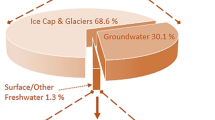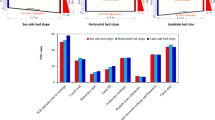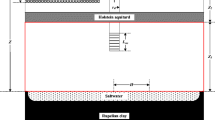Abstract
Saltwater intrusion (SWI) is a type of pollution that adversely affects the quality of groundwater in coastal aquifers. The Nile Delta aquifer (NDA) in Egypt contains a large amount of freshwater. Increasing abstraction from the aquifer and sea level rise have led to an increase in SWI, which has reached up to 100 km inland. Therefore, practical measures are required to prevent further SWI. This study aims to identify an optimal well system to manage the intrusion of saline water in NDA using a number of management systems, including pumping of brackish water, aquifer recharge, and abstraction of the freshwater. SEAWAT code is used to simulate SWI in the aquifer considering different scenarios of pumping and sea level rise. Four scenarios are used to control SWI, including: decreasing pumping from the aquifer, increasing recharge using treated waste water, increasing abstraction of brackish water for desalination, and a combination of these systems. The results showed that increasing recharge could lead to greater retardation of SWI (19.5%) than decreasing pumping (6.2%) and abstraction of brackish water (5.9%). However, a combined well system of pumping, recharge and abstraction is shown to be a more effective tool to control SWI in coastal aquifers, with retardation percentage of 21.3%.
Résumé
L’intrusion d’eau salée (IES) est un type de pollution qui agit défavorablement sur la qualité de l’eau des aquifères côtiers. L’aquifère du Delta du Nil (ADN) en Egypte abrite une part importante d’eau douce. L’augmentation des prélèvements dans l’aquifère et l’élévation du niveau de la mer ont conduit à un accroissement de l’IES, qui s’est étendue jusqu’à 100 km à l’intérieur des terres. Par conséquent, des mesures opérationnelles sont nécessaires pour prévenir une progression de l’IES. La présente étude vise à identifier un dispositif de puits optimisé, destiné à contrôler l’intrusion d’eau salée dans l’ADN, en mettant en œuvre un certain nombre de dispositifs de gestion, incluant un pompage d’eau saumâtre, une recharge de l’aquifère et une extraction d’eau douce. Le programme SEAWAT est utilisé pour simuler l’IES dans l’aquifère, en prenant en compte divers scénarios de pompage et d’élévation du niveau de la mer. Quatre scénarios sont utilisés pour contrôler l’IES, comprenant: décroissance du pompage en aquifère, augmentation de la recharge par de l’eau usée traitée, accroissement de l’extraction d’eau saumâtre pour la désalinisation et combinaison de ces dispositifs. Les résultats montrent que l’accroissement de la recharge pourrait conduire à retarder l’IES davantage (19.5%) que la décroissance du pompage (6.2%) et l’extraction d’eau saumâtre (5.9%). Cependant, un dispositif de puits combinant le pompage, la recharge et l’extraction s’est révélé être un outil plus efficace pour contrôler l’IES dans les aquifères côtiers, avec un taux de retard de 21.3%.
Resumen
La intrusión de agua salada (SWI) es un tipo de contaminación que afecta negativamente a la calidad de las aguas subterráneas de los acuíferos costeros. El acuífero del Delta del Nilo (NDA) en Egipto contiene una elevada cantidad de agua dulce. La cada vez mayor extracción del acuífero y el ascenso del nivel del mar han provocado un aumento de la SWI, que ha llegado hasta 100 km tierra adentro. Por lo tanto, es necesario adoptar medidas prácticas para evitar una mayor SWI. Este estudio pretende identificar un sistema de pozos óptimo para gestionar la intrusión de agua salina en el NDA utilizando varios sistemas de gestión, incluyendo el bombeo de agua salobre, la recarga del acuífero y la extracción del agua dulce. Se utiliza el código SEAWAT para simular la SWI en el acuífero considerando diferentes escenarios de bombeo y ascenso del nivel del mar. Se utilizan cuatro escenarios para controlar el SWI, que incluyen: la disminución del bombeo del acuífero, el aumento de la recarga utilizando aguas residuales tratadas, el aumento de la extracción de agua salobre para la desalinización, y una combinación de estos sistemas. Los resultados mostraron que el aumento de la recarga podía conducir a un mayor retraso de la SWI (19.5%) que la disminución del bombeo (6.2%) y la extracción de agua salobre (5.9%). Sin embargo, un sistema de pozos combinado de bombeo, recarga y extracción se muestra como una herramienta más eficaz para controlar la SWI en los acuíferos costeros, con un porcentaje de retardo del 21.3%.
摘要
咸水入侵 (SWI)是污染类型之一, 会对沿海含水层的地下水质量产生不利影响。埃及尼罗河三角洲含水层(NDA)含有大量的淡水。含水层中开采量的增加和海平面的上升导致了咸水入侵的增加, 已达到内陆100 km。因此, 需要采取措施来防止海水进一步的入侵。本研究旨在通过包括咸水抽取、含水层补给和淡水开采的系列管理措施来确定最佳的井系统来管理尼罗河三角洲含水层的咸水入侵。考虑到开采和海平面上升的不同情景, 采用SEAWAT代码来模拟含水层的咸水入侵。提出控制咸水入侵的四种方案, 包括:减少从含水层的开采量, 利用处理过的废水增加补给量, 增加海水淡化的咸水开采量以及这些方案的组合。结果表明, 增加补给量(19.5%)可能比减小开采量(6.2%)和咸水开采量(5.9%)有更大的咸水入侵阻滞效果。但是, 这几种措施的组合方案在控制沿海含水层咸水入侵更有效, 阻滞百分比为21.3%。
Resumo
A intrusão de água salgada (IAS) é um tipo de poluição que impacta negativamente a qualidade das águas subterrâneas em aquíferos costeiros. O aquífero do Delta do Nilo (ADN), no Egito, contém uma grande quantidade de água doce. O aumento da captação do aquífero e a elevação do nível do mar levaram a um aumento da IAS, que chegou a 100 km no interior. Portanto, são necessárias medidas práticas para evitar mais IAS. Este estudo visa identificar um sistema de poço ideal para gerenciar a intrusão de água salgada no ADN utilizando diversos sistemas de gerenciamento, incluindo bombeamento de água salobra, recarga de aquíferos e captação de água doce. O código SEAWAT é usado para simular IAS no aquífero considerando diferentes cenários de bombeamento e elevação do nível do mar. Quatro cenários são usados para controlar a IAS, incluindo: diminuição do bombeamento do aquífero, aumento da recarga usando água residual tratada, aumento da captação de água salobra para dessalinização, e uma combinação destes sistemas. Os resultados mostraram que o aumento da recarga poderia levar a um maior retardo da IAS (19.5%) do que a diminuição do bombeamento (6.2%) e da captação de água salobra (5.9%). Entretanto, um sistema combinado de bombeamento, recarga e captação de poços demonstrou ser uma ferramenta mais eficaz para controlar a IAS em aquíferos costeiros, com um percentual de retardo de 21.3%.













Similar content being viewed by others
References
Abdelaty IM, Abd-Elhamid HF, Fahmy MR, Abdelaal GM (2014) Study of impact climate change and other on groundwater system in Nile Delta Aquifer. Egyptian J Eng Sci Technol 17(4):2061–2079
Abd-Elaty I, Abd-Elhamid HF, Nezhad MM (2019) Numerical analysis of physical barriers systems efficiency in controlling saltwater intrusion in coastal aquifers. Environ Sci Poll Res 26(35):35882–35899. https://doi.org/10.1007/s11356-019-06725-3
Abd-Elaty I, Abd-Elhamid HF, Qahman K (2020) Coastal aquifer protection from saltwater intrusion using abstraction of brackish water and recharge of treated wastewater: case study of the Gaza aquifer. J Hydrol Eng 25(7):1–15. https://doi.org/10.1061/(ASCE)HE.1943-5584.0001927
Abd-Elhamid HF, Javadi AA (2008) Mathematical models to control saltwater intrusion in coastal aquifer. Proceeding of GeoCongress, New Orleans, LA
Abd-Elhamid HF, Javadi AA (2011) A cost-effective method to control seawater intrusion in coastal aquifers. J Water Resour Manag 25:2755–2780
Abd-Elhamid HF, Abdelaty I, Sherif M (2019) Evaluation of potential impact of Grand Ethiopian Renaissance Dam on seawater intrusion in the Nile Delta Aquifer. Int J Environ Sci Technol 16(5):2321–2332. https://doi.org/10.1007/s13762-018-1851-3
Abd-Elhamid HF, Abd-Elaty I, Hussain MS (2020a) Mitigation of seawater intrusion in coastal aquifers using coastal earth fill considering future sea level rise. Environ Sci Pollut Res 27:23234–23,245. https://doi.org/10.1007/s11356-020-08891-1
Abd-Elhamid HF, Abd-Elaty I, Sherif MM (2020b) Effects of aquifer bed slope and sea level on saltwater intrusion in coastal aquifers. Hydrology 7(1):5
Amer A, Farid MS (1981) About sea water intrusion phenomenon in the Nile Delta aquifer. Proceedings of the International Workshop on Management of the Nile Delta Groundwater Aquifer. CU/MIT, Cairo
Amer A, Sherif MM (1996) An integrated study for seawater intrusion in the Nile Delta aquifer. Working paper for SRP. NWRC-MPWWR, Cairo
Bear J, Cheng AH, Sorek S, Quazar D, Herrera I (1999) Seawater intrusion in coastal aquifers: concepts, methods and practices. Kluwer, Dordrecht, The Netherlands
Barrocu G, Cau P, Muscas L, Soddu S, Uras G (2004) Predicting groundwater salinity changes in the coastal aquifer of Arborea (central-western Sardinia). Proceedings of the 18th Salt Water Intrusion Meeting, Cartagena, Spain, 31 May–3 June 2004
Bhattacharjya R, Datta B (2005) Optimal management of coastal aquifers using linked simulation optimization approach. Water Resour Manag 19:295–320
Darwish MM (1994) Effect of probable hydrological changes on the Nile Delta aquifer system. PhD Thesis, Faculty of Engineering, Cairo University, Cairo, Egypt
Farid MS (1980) Nile Delta groundwater study. MSc Thesis, Faculty of Engineering, Cairo University, Egypt
Farid MS (1985) Management of groundwater system in the Nile Delta. PhD Thesis, Faculty of Engineering, Cairo University, Egypt
Hefny KH (1980) Groundwater in the Nile Valley (in Arabic). Ministry of Irrigation. Water Research Center, Groundwater Research Inst, Cairo, pp 1–120
Hong S, Park N, Bhopanam N, Han S (2004) Verification of optimal model of coastal pumping with sand-tank experiment. Proceeding of the 18th Salt Water Intrusion Meeting, Cartagena, Spain, 31 May–3 June 2004
IPCC (1996) In: Houghton JT, Meira Fihlo LG, Callander BA, Harris N, Kattenberg A, Maskell K (eds) Climate change: the science of climate change—contribution of Working Group I to the second assessment report of the Intergovernmental Panel on Climate Change. Cambridge University Press, Cambridge
IPCC Climate Change (2001) In: McCarthy JJ, Canziani OF, Leary NA, Dokken DJ, White KS (eds) Impacts, adaptations, and vulnerability: contribution of Working Group II to the third assessment report of the Intergovernmental Panel on Climate Change. Cambridge University Press, Cambridge
Javadi AA, Abd-Elhamid HF, Farmani R (2012) A simulation-optimization model to control seawater intrusion in coastal aquifers using abstraction/recharge wells. Int J Numeric Analytic Methods Geomech 36(16):1757–1779
Javadi AA, Hussaina M, Sherif M (2013) Optimal control of seawater intrusion in coastal aquifers. International Conference on Computational Mechanics (CM13), Durham, UK, 25–27 March 2013
Javadia AA, Hussaina M, Sherif M, Farmani R (2015) Multi-objective optimization of different management scenarios to control seawater intrusion in coastal aquifers. Water Resour Manage 29:1843–1857
Johnson T, Spery M (2001) Direct potable use of intruded seawater from west coast basin aquifers, Los Angeles country, California. Proceedings of the 1st international conference and workshop on Saltwater Intrusion and Coastal Aquifers: Monitoring, Modelling, and Management, Morocco, April 2001
Kacimov AR, Sherif MM, Perret JS, Al-Mushikhi A (2009) Control of sea-water intrusion by salt-water pumping Coast of Oman. Hydrogeol J 17:541–558
Kashef A (1976) Control of saltwater intrusion by recharge wells. J Irrig Drainage Division 102:445–456
Langevin CD, Thorne DT, Jr., Dausman AM, Sukop MC, Guo W (2007) SEAWAT Version 4: a computer program for simulation of multi-species solute and heat transport. USGS Techniques and Methods, book 6, chap A22, US Geological Survey, Reston, VA, 39 pp
Mabrouk MB, Jonoski A, Solomatine D, Uhlenbrook S (2013) A review of seawater intrusion in the Nile Delta groundwater system the basis for assessing impacts due to climate changes and water resources development. J Hydrol Earth Syst Sci 10:10873–10,911
Mahesha A (1996a) Transient effect of battery of injection wells on seawater intrusion. J Hydraulic Eng ASCE 122:266–271
Mahesha A (1996b) Control of seawater intrusion through injection-extraction well system. J Irrig Drainage Eng ASCE 122:314–317
Maimone M, Fitzgerald R (2001) Effective modelling of coastal aquifers systems. Proceedings of the 1st international conference and workshop on Saltwater Intrusion and Coastal Aquifers: Monitoring, Modelling, and Management, Morocco, April 2001
Narayan KA, Schleeberger C, Charlesworth PB, Bristow KI (2006) Effects of groundwater pumping on saltwater intrusion in the lower Burdekin Delta, north Queensland. CSIRO Land and Water, Davies Laboratory, Townsville, Australia
Morsy WS (2009) Environmental management to groundwater resources for Nile Delta region. PhD Thesis, Faculty of Engineering, Cairo University, Egypt
Molle F, Gaafar I, El-Agha DE, Rap E (2016) Irrigation Efficiency and the Nile Delta Water Balance, Water and salt management in the Nile Delta: Report no. 9, International Water Management Institute and Australian Center for International Agriculture Research, Canberra
Nofal ER, Amer MA, El-Didy SM, Fekry AM (2015) Delineation and modeling of seawater intrusion into the Nile Delta Aquifer: a new perspective. Water Sci 29(2):156–166
Paniconi C, Khlaifi I, Lecca G, Giacomelli A, Tarhouni J (2001) A modelling study of seawater intrusion in the Korba plain, Tunisia. Physics Chem Earth (B) 26(4):345–351
Papadopoulou MP, Karatzas GP, Koukadaki MA, Trichakis Y (2005) Modelling the saltwater intrusion phenomenon in coastal aquifers: a case study in the industrial zone of Herakleio in Crete. Global NEST J 7(2):197–203
Qahman K, Larabi A (2004) Three dimensional numerical models of seawater intrusion in Gaza aquifer, Palestine. Proceedings of the 18th Salt Water Intrusion Meeting, Cartagena, Spain, 31 May–3 June 2004
RIGW (1992) Hydrogeological map of Egypt: map sheet of Nile Delta. Research Institute for Groundwater, National Water Research Center, Kanater El Khairia, Egypt
RIGW (2002) Nile Delta groundwater modeling report. Research Inst. for Groundwater, Kanater El-Khairia, Egypt
RIGW (2003) Monitoring of groundwater microbiological activities in the Nile Delta Aquifer. In: A study completed for the National Water Quality and Availability Management project (NAWQAM). Kanater El-Khairia, Egypt
RIGW (Research Institute for Groundwater) (1980) Projected of the Safe Yield Study for Groundwater Aquifer in the Nile Delta and Upper Egypt, part 1 (in Arabic). Ministry of Irrigation, Academy of Scientific Research and Technology, and Organization of Atomic Energy, Cairo, Egypt
RIGW/IWACO (1999) Environmental management of groundwater resources (EMGR). Final technical report TN/70.0067/WQM/97/20, Research Inst. for Groundwater, Kanater El-Khairia, Egypt
Sakr SA (2005) Impact of the possible sea level rise on the Nile Delta aquifer: a study for Lake Nasser Flood and Drought Control Project (LNFDC/ICC). Planning Sector, Ministry of Water Resources and Irrigation, Cairo
Sallouma MKM (1983) Hydrogeological and hydrochemical studies east of Nile Delta, Egypt, PhD Thesis, Ain Shams Univ., Cairo, 166 pp
Scholze O, Hillmer G, Schneider W (2002) Protection of the groundwater resources of Metropolis CEBU (Philippines) in consideration of saltwater intrusion into the coastal aquifer. Proceedings of the 17th Salt Water Intrusion Meeting, Delft, The Netherlands
Serag El Din HM (1989) Geological, hydrochemical and hydrological studies on the Nile Delta Quaternary Aquifer. PhD Thesis, Mansoura Univ., Mansoura, Egypt
Sherif MM, Hamza KI (2001) Mitigation of seawater intrusion by pumping brackish water. J Transport Porous Media 43(1):29–44
Sherif M, Kacimov A (2008) Pumping of brackish and saline water in coastal aquifers: an effective tool for alleviation of seawater intrusion. Proceedings of 20th SWIM. Naples, FL, June 2008
Sherif MM, Singh VP (1999) Effects of climate change on sea water intrusion in coastal aquifers. Hydrol Processes J 13:1277–1287
Sherif MM, Singh VP, Amer AM (1988) A two-dimensional finite element model for dispersion (2D-FED) in coastal aquifers. Hydrol J 103:11–36
Sherif MM, Singh VP, Amer AM (1990) A note on saltwater intrusion in coastal aquifers. Water Resour Manag 4:123–134
Sherif MM, Sefelnasr A, Javadi A (2012) Incorporating the concept of equivalent freshwater head in successive horizontal simulations of seawater intrusion in the Nile Delta Aquifer, Egypt. J Hydrol 464–465:186–198
Todd DK (1974) Saltwater intrusion and its control. J Am Water Works Assoc 66(3):180–187
Zhou X, Chen M, Liang C (2003) Optimal schemes of groundwater exploitation for prevention of seawater intrusion in the Leizhou Peninsula in southern China. Environ Geol 43:978–985
Funding
The authors would like to thank the Water and Water Structures Engineering, Faculty of Engineering, Zagazig University, for supporting this research.
Author information
Authors and Affiliations
Corresponding author
Additional information
Publisher’s note
Springer Nature remains neutral with regard to jurisdictional claims in published maps and institutional affiliations.
Rights and permissions
About this article
Cite this article
Abd-Elaty, I., Javadi, A.A. & Abd-Elhamid, H. Management of saltwater intrusion in coastal aquifers using different wells systems: a case study of the Nile Delta aquifer in Egypt. Hydrogeol J 29, 1767–1783 (2021). https://doi.org/10.1007/s10040-021-02344-w
Received:
Accepted:
Published:
Issue Date:
DOI: https://doi.org/10.1007/s10040-021-02344-w




